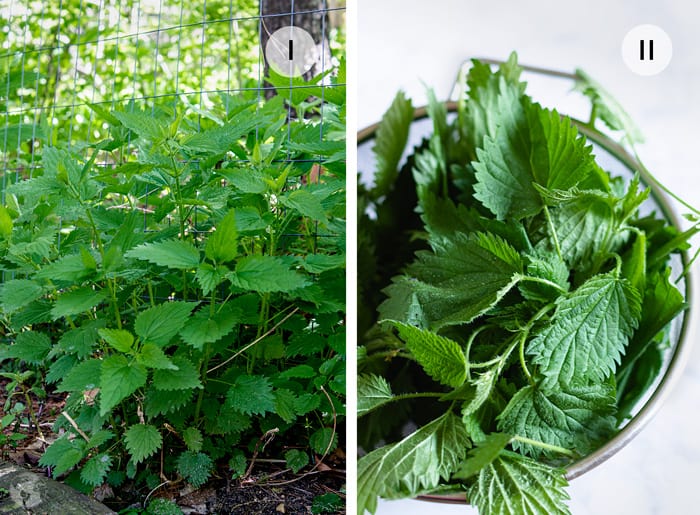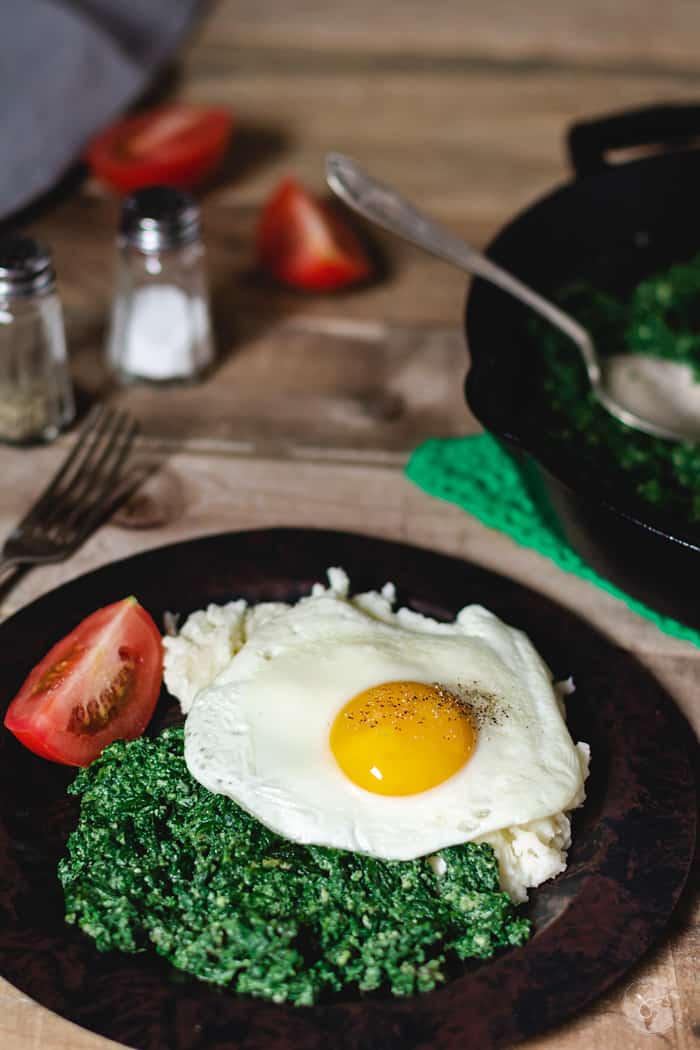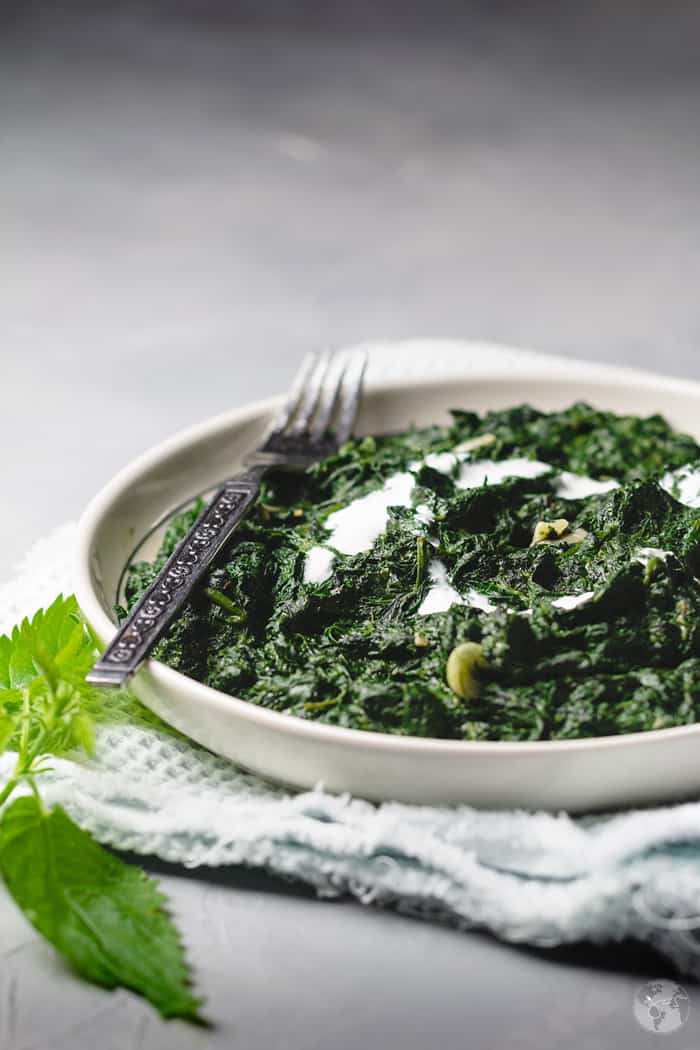A simple creamy side dish of stinging nettle is a delicious and quick way to add vitamins, minerals, and protein to your diet. Cooked then sautéed in butter with garlic, nutmeg, and sour cream/milk mixture, this Balkan-style dish is easy and quick. Best of all, it is nutritious and delicious!

I know what you’re thinking – stinging, huh? You expect me to eat something with the word “stinging” in its name? Right. Well, I do...after you read this blog post! I grew up eating stinging nettle mixed with spinach, and there are several different cuisines that use it in a variety of ways.
What is Stinging Nettle?
Stinging nettle is a perennial wild plant that gets its name from the stinging of the tiny hairs on the leaves when they come in contact with skin. It has long been used for medicinal purposes, food, and textile material dating back to ancient societies. This is probably one of the most nutrient-dense plants you could ever hope to eat.
Benefits of stinging nettle:
So why should you eat stinging nettle? And how do you incorporate it into your diet? Well, here are ten good reasons!
- The anti-inflammatory properties in stinging nettle can help relieve arthritis pain when applied topically. There is also a study that shows the nettle can fight other autoimmune diseases, such as rheumatoid arthritis.
- It has diuretic properties, helping to provide relief from bloating and help treat urinary tract diseases.
- Due to its antihistamine and anti-inflammatory properties, stinging nettle is a natural treatment for eczema.
- It has antiviral, antibacterial, and antifungal properties, which can help fight off infections in the body.
- Because of its range of beneficial nutrients and diuretic properties, stinging nettle is an effective detoxifier for the body. It gently cleanses the body of these toxins, and then can quickly flush them out.
- It can help reduce nasal allergies and allergic reactions.
- Stinging nettle leaves and stems contain chemicals that can help release insulin and control blood sugar.
- The iron and Vitamin C in stinging nettle can help improve blood circulation in the body and increase blood cell production. This can speed up the healing process in the body.
- It can help treat several respiratory conditions, such as asthma and hay fever.
- Stinging nettle contains boron, which is linked to helping maintain strong bones. Consuming this edible plant may help to combat osteoporosis.
Nettle in cuisines
So, hopefully, I have convinced you that this “stinging” herb is perfectly fine to consume. So, what are the best ways to do it? To give you a little help with stomaching this plant, think of it as stronger spinach. In fact, I often mix this with spinach, despite my husband asking me not to trick him into eating it. Sorry hun, it’s for your own good!
Different regions use stinging nettle in different ways. Nettle soup is a popular recipe in Scandinavia, Iran, Ireland, and Eastern Europe. In Albania, the baby leaves are simmered and used as a part of the dough filling for the börek. My mom also used to mix it with cheese to stuff sheets of fillo dough.
Tešanjski cheese, which is made from the nettle and milk, originates in the Tešanj district in northern central Bosnia and Herzegovina. Stinging nettle (aka Kopriva in Bosnian) is also a common ingredient in pesto and polenta in Northern and Central Italy.
Where can I find this prickly plant?
Originally from Europe, stinging nettle has naturalized throughout most of the United States. You can find them growing in early spring along streams, lakes, rivers, ditches, fencerows, around cultivated farm fields, vacant lots, and on the edges of my backyard. 😉
It's easy to grow your own. I planted the seeds at the edge of the wooded area and I haven't once water it or fertilized it. It's a hearty perennial plant that grows under any condition with minimum to no care.
How to harvest nettles?
Harvest before they grow to be too tall (about a foot). Wear rubber gloves and only pick the first two or three pairs of leaves from the tops of plants. Carefully place nettles into a paper or plastic bag for transport. Also, make sure you protect your legs while harvesting. No skin should be exposed.
What happens if I touch it?
If you get stung by the plant, your skin will be red and swollen. You'll have a burning and itching sensation that usually goes away within 24 hours. Wash the area with soap and water as soon as possible and avoid scratching or rubbing the itchy areas.
How to use it in cooking?
Cooking and eating nettle can be as simple as pretending it's spinach! Just cut the leaves from the stems, rinse them, and you can sauté them with other vegetables, make a pesto, add them to omelets, casseroles, pasta, and more.
And yes, the “stinging” prickles on the leaves go away when you cook them!
*Keep scrolling to get the full (printable) recipe and ingredient amounts.
You will love it in place of spinach and Swiss chard in these recipes:
- SPINACH AND CHEESE FILLO PIE
- SWISS CHARD AND POTATOES
- SPINACH AND ARTICHOKE GRILLED CHEESE
- FRITTATA WITH GREENS AND GOAT CHEESE
This recipe for creamy stinging nettle is the typical side dish in Bosnia and surrounding regions (the way my mom makes it) and it's best served along with mashed potatoes and fish or meat of choice, or fried eggs like in this old photo.
Recipe Notes/Expert Tips:
- Wear rubber gloves while harvesting, washing, and adding stinging nettles to the pot. Once cooked, they will not sting.
- Only pick the first two or three pairs of leaves from the tops of young plants. Do not use nettles that are flowering.
- The best way to clean the nettles is to soak them in cold water for a few minutes. Gently remove them from the water and repeat at least three times, using fresh water each time.
- Use gluten-free flour if you're gluten intolerant.
- For a different variation, whisk two eggs with sour cream and milk mixture.
- Use half spinach and half nettle to get used to the nettle flavor.
- If you can't find nettles, prepare spinach or Swiss chard following this recipe.
- You can chop cooked nettle with a knife or in a blender if that's how you prepare spinach. I like to leave the leaves whole.
- Creamy nettle is easily reheated but it tastes the best when served immediately.
- You can reserve the water of cooked nettles and drink it like tea. It is so good for you (read all the benefits in the post).
What to serve with this creamy nettle dish?
Creamy stinging nettle is a wonderful side dish for any roasted meat and fish. Try serving alongside these dishes:
- HONEY MUSTARD PORK ROAST
- EASY CLASSIC WIENER SCHNITZEL
- THE BEST CRUSTED SALMON RECIPE
- HONEY-GLAZED PORK CHOPS

Creamy Stinging Nettle Recipe
EQUIPMENT
- strainer/sieve
- gloves
Ingredients
- 1 pound stinging nettle
- 2 tablespoons butter
- 2 garlic cloves, sliced or minced
- 1 tablespoon all-purpose flour
- ½ cup reserved nettle cooking liquid
- ¼ teaspoon ground nutmeg
- ⅓ cup milk
- 2 tablespoons sour cream
- Salt and freshly ground black pepper to taste
Instructions
- Clean and rinse one pound stinging nettles. Bring a large pot of water to a boil. Add nettles and cook until wilted, about 5-10 minutes. Drain in a colander.
- In a large cast iron or non-stick skillet, heat the two tablespoons butter and two garlic cloves over medium heat, until garlic is fragrant, about 30 seconds.
- Whisk in one tablespoon flour and cook until smooth and bubbly, about one minute.
- Add the nettle and ½ cup reserved cooking liquid. Simmer the nettle, stirring, until the liquid has evaporated, about 10 minutes.
- In a small bowl, whisk together ⅓ cup milk and two tablespoons sour cream. Stir into the nettles. Add a pinch of nutmeg; season with salt and pepper to taste. Cook over medium heat until mixture thickens, about 3-5 minutes.
- Add a swirl of sour cream on top if you wish. Enjoy!
Notes
- Wear rubber gloves while harvesting, washing, and adding stinging nettles to the pot. Once cooked, they will not sting.
- Only pick the first two or three pairs of leaves from the tops of young plants. Do not use nettles that are flowering.
- The best way to clean the nettles is to soak them in cold water for a few minutes. Gently remove them from the water and repeat at least three times, using fresh water each time.
- Use gluten-free flour if you're gluten intolerant.
- For a different variation, whisk two eggs with sour cream and milk mixture.
- Use half spinach and half nettle to get used to the nettle flavor.
- If you can't find nettles, prepare spinach or Swiss chard following this recipe.
- You can chop cooked nettle with a knife or in a blender if that's how you prepare spinach. I like to leave the leaves whole.
- Creamy nettle is easily reheated but it tastes the best when served immediately.
- You can reserve the water of cooked nettles and drink it like tea. It is so good for you (read all the benefits in the post).

















Kelly | Foodtasia says
Well Jas, you've convinced me that I should try it! I wonder if the farmer's market would have any? The name is very intimidating, as well as the process of harvesting it. I wonder what the first person to try to eat stinging nettle was thinking!
Jas says
Haha, no kidding! I'm glad they did though. Farmers market would be a good place to look for it. I also know some people sell it on Etsy. Thanks for stopping in, Kelly! xx
Amy Johnson says
I live near a creek and this weed is a constant issue in my garden. I’m forever digging it up. I had no idea it was edible. Interesting.
Jas says
Oh, wow. I brought the seeds from my home country and it took me four years to grow enough of them to make it once or twice while in season (since you can only use the tips of a young plant), ha!
Ron says
Jaz, what a great post. Here in Sweden Spring means Nässelsoppa (nettle soup), so the concept of eating stinging nettle is no problem. Your Creamy Stinging Nettle dish sound great. We're planing a trip into the forest this weekend so I'll bring my gloves and harvest some nettle. You know you can actually buy fresh picked nettle here at our veggie market. But why pay when you can pick it for free. Thanks for sharing.